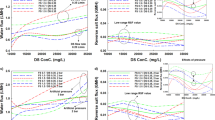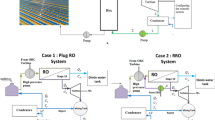Abstract
Forward osmosis (FO) has been proposed as an alternative method for seawater desalination, wherein reverse osmosis (RO) membrane technology is used for regeneration of the draw solution. Previous studies have indicated that a standalone RO unit is more energy efficient than an FO–RO system, and as such it was recommended that an FO–RO system is best employed only for the desalination of high-salinity seawaters. This study examined FO–RO applicability in more detail by examining the impact of seawater salinity, impact of an energy recovery device (ERD), and the effect of membrane fouling. For comparison purposes, the performance of the FO process was improved to minimize the impact of concentration polarization and optimize the concentration of draw solution. Model calculations revealed that FO–RO is more energy efficient than RO when no ERD was employed. However, results showed that there was no significant difference in the power consumption between the FO–RO system and the RO unit at high seawater salinities particularly when a high-efficiency ERD was installed. Moreover, the FO–RO system required more membrane area than a conventional RO unit which may further compromise the FO–RO desalination cost.







Similar content being viewed by others
References
Achilli A, Cath TY, Childress AE (2009) Power generation with pressure retarded osmosis: an experimental and theoretical investigation. J Membr Sci 343:42–52
Al-Mutaz IS, Wazeer I (2015) Current status and future directions of MED-TVC desalination technology. Desalin Water Treat 55:1–9
AlTaee A, Sharif AO (2011) Alternative design to dual stage NF seawater desalination using high rejection brackish water membranes. Desalination 273:391–397
Altaee A, Zaragoza G (2014) A conceptual design of low fouling and high recovery FO-MSF desalination plant. Desalination 343:2–7
Altaee A, Mabrouk A, Bourouni K (2013) A novel forward osmosis membrane pretreatment of seawater for thermal desalination processes. Desalination 326:19–29
Altaee A, Zaragoza G, van Tonningen HR (2014) Comparison between forward osmosis–reverse osmosis and reverse osmosis processes for seawater desalination. Desalination 336:50–57
Bataineh KM (2016) Multi-effect desalination plant combined with thermal compressor driven by steam generated by solar energy. Desalination 385:39–52
Bates W, Bartels C, Polonio L (2015) Improvements in RO technology for difficult feed waters. Hydranautics Nito Dinko. http://www.membranes.com/docs/papers/New%20Folder/Improvements%20in%20RO%20Technology%20for%20Difficult%20Feed%20Waters%20final%20020311.pdf
Bennett A (2015) Developments in desalination and water reuse. Filtr Sep 52:28–33
Bhinder A, Fleck BA, Pernitsky D, Sadrzadeh M (2016) Forward osmosis for treatment of oil sands produced water: systematic study of influential parameters. Desalin Water Treat. doi:10.1080/19443994.2015.1108427
Chekli L, Phuntsho S, Kim JE, Kim J, Choi JY, Choi J-S, Kim S, Kim JH, Hong S, Sohn J, Shon HK (2016) A comprehensive review of hybrid forward osmosis systems: performance, applications and future prospects. J Membr Sci 497:430–449
Chung T-S, Luo L, Wan CF, Cui Y, Amy G (2015) What is next for forward osmosis (FO) and pressure retarded osmosis (PRO). Sep Purif Technol 156(2):856–860
Cipollina A, Tzen E, Subiela V, Papapetrou M, Koschikowski J, Schwantes R, Wieghaus M, Zaragoza G (2015) Renewable energy desalination: performance analysis and operating data of existing RES-desalination plants. Desalin Water Treat 55(11):3120–3140
Dimitriou E, Mohamed ES, Karavas C, Papadakis G (2015) Experimental comparison of the performance of two reverse osmosis desalination units equipped with different energy recovery devices. Desalin Water Treat 55:3019–3026
Gilron J (2014) Water-energy nexus: matching sources and uses. Clean Technol Environ Policy 16(8):1471–1479
Gude VG (2011) Energy consumption and recovery in reverse osmosis. Desalin Water Treat 36:239–260
Gude VG (2016) Desalination and sustainability—an appraisal and current perspective. Water Res 89:87–106
Hoang M, Bolto B, Haskard C, Barron O, Gray S, Leslie G (2009) Desalination plants: an australia survey. Water 36:67–73
Horta P, Zaragoza G, Alarcón-Padilla DC (2015) Assessment of the use of solar thermal collectors for desalination. Desalin Water Treat 55(10):2856–2867
Hydranautics Design Limits (2015) Hydranautics Nito Dinko. www.membranes.com/docs/trc/Dsgn_Lmt.pdf
Iwahori H, Ando M, Nakahara R, Furuichi M, Tawata S, Yamazato T (2003) Seven years operation and environmental aspects of 40,000 m3/d seawater RO plant at Okinawa, Japan. In: Proceedings of the IDA congress, Bahamas
Jiang Y (2015) China’s water security: current status, emerging challenges and future prospects. Environ Sci Policy 54:106–125
Kim SJ, Oh BS, Yu HW, Kim LH, Kim CM, Yang ET, Shin MS, Jang A, Hwang MH, Kim IS (2015) Foulant characterization and distribution in spiral wound reverse osmosis membranes from different pressure vessels. Desalination 370:44–52
Luo H, Wang Q, Zhang TC, Tao T, Zhou A, Chen L, Bie X (2014) A review on the recovery methods of draw solutes in forward osmosis. J Water Process Eng 4:212–223
Majeed T, Sahebi S, Lotfi F, Kim JE, Phuntsho S, Ti**g LD, Shon HK (2015) Fertilizer-drawn forward osmosis for irrigation of tomatoes. Desalin Water Treat 53(10):2746–2759
Mamo J, Pikalov V, Arrieta S, Jones AT (2013) Independent testing of commercially available, high-permeability SWRO membranes for reduced total water cost. Desalin Water Treat 51:184–191
Maxwell S (2010) A look at the challenges—and opportunities—in the world water market. J Am Water Works Assoc 102:104–116
Mazlan NM, Peshev D, Livingston AG (2016) Energy consumption for desalination—a comparison of forward osmosis with reverse osmosis, and the potential for perfect membranes. Desalination 377:138–151
McGovern RK, Lienhard JHV (2014) On the potential of forward osmosis to energetically outperform reverse osmosis desalination. J Membr Sci 469:245–250
Mezher T, Fath H, Abbas Z, Khaled A (2011) Techno-economic assessment and environmental impacts of desalination technologies. Desalination 266:263–273
Nasr P, Sewilam H (2015) Forward osmosis: an alternative sustainable technology and potential applications in water industry. Clean Technol Environ Policy V17:2079–2090
Patroklou G, Mujtaba MI (2014) Economic optimisation of seawater reverse osmosis desalination with boron rejection. Comput Aided Chem Eng V33:1381–1386
Peñate B, García-Rodríguez L (2011) Energy optimisation of existing SWRO (seawater reverse osmosis) plants with ERT (energy recovery turbines): technical and thermoeconomic assessment. Energy 36:613–626
Qin JJ, Liberman B, Kekre KA (2009) Direct osmosis for reverse osmosis fouling control: principles, applications and recent developments. Open Chem Eng J 3:8–16
Rachman RM, Ghaffour N, Wali F, Amy GL (2013) Assessment of silt density index (SDI) as fouling propensity parameter in reverse osmosis (RO) desalination systems. Desalin Water Treat 51:1091–1103
Rodríguez-Calvo A, Silva-Castro GA, Osorio F, González-López J, Calvo C (2015) Reverse osmosis seawater desalination: current status of membrane systems. Desalin Water Treat 56(4):849–861
Roy D, Rahni M, Pierre P, Yargeau V (2016) Forward osmosis for the concentration and reuse of process saline wastewater. Chem Eng J 287:277–284
Salgot M (2008) Water reclamation, recycling and reuse: implementation issues. Desalination 218:190–197
Sato Y, Nakao S-I (2016) Theoretical estimation of semi-permeable membranes leading to development of forward osmosis membranes and processes as a future seawater desalination technology. Desalin Water Treat 57(12):5398–5405
Shaffer DL, Werber JR, Jaramillo H, Lin S, Elimelech M (2015) Forward osmosis: where are we now? Desalination 356:271–284
Stover RL (2007) Seawater reverse osmosis with isobaric energy recovery devices. Desalination 203:168–175
Su J, Zhang S, Ling MM, Chung T-S (2012) Forward osmosis: an emerging technology for sustainable supply of clean water. Clean Technol Environ Policy 14(4):507–511
Sun C, **e L, Li X, Sun L, Dai H (2015) Study on different ultrafiltration-based hybrid pretreatment systems for reverse osmosis desalination. Desalination 371:18–25
Tiraferri A, Yip NY, Straub AP, Castrillon Romero-Vargas S, Elimelech M (2013) A method for the simultaneous determination of transport and structural parameters of forward osmosis membranes. J Membr Sci 444:523–538
Valladares RL, Li Z, Sarp S, Bucs SS, Amy G, Vrouwenvelder JS (2014) Forward osmosis niches in seawater desalination and wastewater reuse. Water Res 66:122–139
Webley J (2015) Technology developments in forward osmosis to address water purification. Desalin Water Treat 55:2612–2617
Youssef PG, Al-Dadah RK, Mahmoud SM (2014) Comparative analysis of desalination technologies. Energy Procedia 61:2604–2607
Zhao D, Chen S, Guo CX, Zhao Q, Lu X (2016) Multi-functional forward osmosis draw solutes for seawater desalination. Chin J Chem Eng 24(1):23–30
Author information
Authors and Affiliations
Corresponding author
Appendices
Appendix 1: Optimization of FO performance
FO optimization was performed to reduce the energy requirements of the FO–RO system. Calculation was carried out at 35 g/L seawater salinity and 46 % recovery rate using NaCl draw solution. We assumed that Q p was equal in both the FO and RO membranes and Q Di was 1000 L/h (Table 3); permeate flow rate of the RO step in the FO–RO system was given as
Membrane flux, J w, was calculated from the following equation assuming that FO membrane area was 250 m2 (Table 3):
The permeate TDS was calculated from Eq. 22 and using B value from Table 1 as follows:
The outlet concentration of Na, C Nao, was calculated from Eq. 18; \(\pi_{\text{Do}} (\pi_{\text{Do}} = \pi_{\text{Fi}} + 2)\) was 28.2 bar (Table 3) and C Clo = 1.54 × C Nao:
The outlet concentration of Cl, C Clo, was calculated from the following equation:
The outlet concentration of NaCl draw solution is 35,233 mg/L. Inlet concentration of the draw solution was calculated from mass balance (Fig. 3) using Eq. 21:
The inlet concentrations of Na+ and Cl−, C Nai and C Cli, respectively, were
The inlet osmotic pressure of draw solution, \(\pi_{\text{Di}} ,\) was calculated from C Nai and C Cli as follows:
The bulk osmotic pressure of draw solution, \(\pi_{\text{Db}} ,\) was (51.4 + 28.2)/2 = 39.8 bar. The bulk osmotic pressure of the feed solution, \(\pi_{\text{Fb}} ,\) was calculated from Eq. 23 as follows:
The outlet osmotic pressure of feed solution, \(\pi_{\text{Fo}} ,\) was calculated from Eq. 24:
FO recovery rate was calculated from Eq. 27 as follows:
The feed flow rate was calculated from Eq. 28:
Appendix 2: Water flux decline in RO
Annual decline in membrane flux was calculated from Eq. 2, assuming 8 and 3 % annual flux decline in the conventional RO and the RO step in the FO–RO system, respectively. For the FO–RO system operating at 46 % recovery rate and 3 % annual flux decline, the initial water flux was 6.19 L/m2 h. Water flux in year 1 was calculated as follows (Fig. 8):
Rights and permissions
About this article
Cite this article
Altaee, A., Millar, G.J., Zaragoza, G. et al. Energy efficiency of RO and FO–RO system for high-salinity seawater treatment. Clean Techn Environ Policy 19, 77–91 (2017). https://doi.org/10.1007/s10098-016-1190-3
Received:
Accepted:
Published:
Issue Date:
DOI: https://doi.org/10.1007/s10098-016-1190-3





